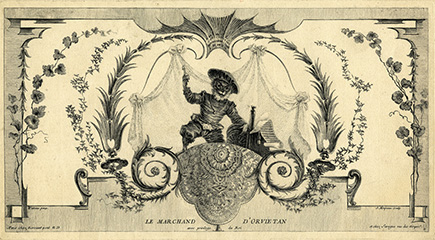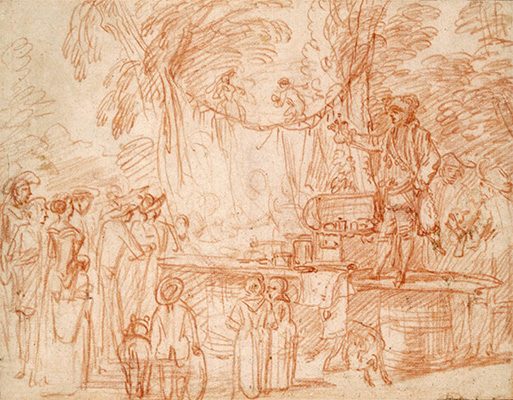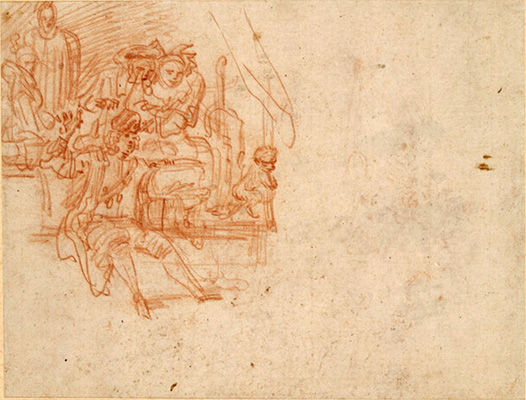
- Home Page
- Accepted
Paintings & Copies - Doubtful
Attributions - Doubtful Textual References
- Alternative
Titles - Collectors &
Museums - Bibliography
- Search Abecedario
- Watteau &
His Circle
Le Marchand d’orvietan
Entered October 2025

Presumed lost
Materials unknown
Measurements unknown
RELATED PRINTS

Jean Moyreau after Watteau, Le Marchand d’Orvietan, c. 1729, engraving.
This decorative composition was engraved by Jean Moyreau and was announced for sale in the April 1729 issue of the Mercure de France (p. 750). The caption of the engraving states “Watteau pinxit,” the "pinxit" assuring us that the print was made from a painted arabesque and not just a preparatory drawing.
Le Marchand d’orvietan and its pendant, La Favorite de Flore, also engraved by Moyreau, were announced as part of a suite of four decorative designs. The other two, Le Berger content and L’Heureux moment, were engraved by Louis Crépy fils. Those figures are set to a different scale and the decorative surrounds are unrelated to those here. In other words, the two sets of arabesques are unrelated.
PROVENANCE
Paris, with Edme François Gersaint (1694-1750; dealer in paintings and luxury goods), according to the Mercure de France, April 1729 (p. 750): “Le Sieur Gersaint voyant que les Curieux recevoient favorablement les morceaux d'ornemens qu'il a fait graver, d'après les Tableaux & Desseins originaux faits par VATTEAU, a été encouragé de faire continuer les autres ouvrages du même Auteur qu'il avoit entre les mains (. . .).” The latter phrase implies that Gersaint owned the painting.
SELECT BIBLIOGRAPHY
Goncourt, Catalogue raisonné (1875), cat. 301.
Dacier, Vuaflart, and Hérold, Jean de Jullienne et les graveurs (1921-29), 3: cat. 8.
Réau, “Watteau” (1928), cat. 275.
Adhémar, Watteau (1950), cat. 80
Montagni and Macchia, Tutti l’opera di Watteau (1968),cat. 39B.
RELATED DRAWINGS
No Watteau drawings can be directly associated with Le Marchand d’orvietan.
REMARKS
The subject should be read as a parody on several levels. Simply put, all singeries mock humans and human activities. Watteau often turned to singeries, especially when he worked with Claude III Audran. He designed decors with monkeys mimicking human activities on the ceiling of the hôtel de Nointel (see Eidelberg 2002), Les Singes de Mars, and drawings for wall decorations with monkeys playing drums (Rosenberg and Prat R758) and with monkeys banqueting (Rosenberg and Prat R756).
Watteau also employed the theme of singeries as subjects for small easel paintings such as La Peinture and La Sculpture.
In the case of Le Marchand d’orvietan, the parody extends to what the monkey is selling. Orvietan was a medical concoction popular since the early seventeenth century that was valued as a panacea against poisons, deadly mushrooms, and venomous animals.

Watteau, Quack Doctors Demonstrating their Products (verso), red chalk, 17.7 × 22.8 cm. Oxford, Ashmolean Museum.

Watteau, Quack Doctors Demonstrating their Products (recto), red chalk, 17.7 × 22.8 cm. Oxford, Ashmolean Museum.
These vendors were fairground attractions, and Watteau portrayed several such quack doctors, seemingly drawn from life, in a double-sided study of a fairground where fake doctors hawk their wares and monkeys play about on tightropes and peer out into the audience (Rosenberg and Prat 19).
As can be expected, the scholars who have considered Le Marchand d’orvietan have disagreed about its date. Adhémar placed it c. 1712, while Macchia and Montagni preferred c. 1709.